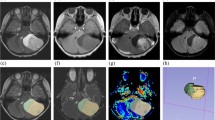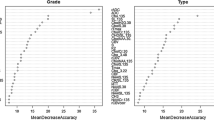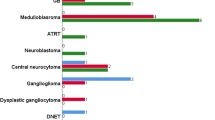Abstract
Purpose
Susceptibility-weighted imaging (SWI) is useful for glioma grading and discriminating between brain tumor categories in adults, but its diagnostic value for pediatric brain tumors is unclear. Here we evaluated the usefulness of SWI for pediatric tumor grading and differentiation by assessing intratumoral susceptibility signal intensity (ITSS).
Methods
We retrospectively enrolled 96 children with histopathologically diagnosed brain tumors, who underwent routine brain MRI exam with SWI (1.5 T scanner). Each tumor was assigned an ITSS score by a radiology resident and an experienced neuroradiologist, and subsequently by consensus. Statistical analyses were performed to differentiate between low-grade (LG) and high-grade (HG) tumors, histological categories, and tumor locations. Inter-reader agreement was assessed using Cohen’s kappa (κ).
Results
The interobserver agreement was 0.844 (0.953 between first reader and consensus, and 0.890 between second reader and consensus). Among all tumors, we found a statistically significant difference between LG and HG for ITSS scores of 0 and 2 (p = 0.002). This correlation was weaker among astrocytomas alone, and became significant when considering only off-midline astrocytomas (p = 0.05). Scores of 0 and 2 were a strong discriminating factor (p = 0.001) for astrocytomas (score 0) and for embryonal, choroid plexus, germ-cell, pineal, and ependymoma tumors (score 2). No medulloblastoma showed a score of 0.
Conclusions
Our preliminary ITTS results in pediatric brain tumors somewhat differed from those obtained in adult populations. These findings highlight the potential valuable role of ITSS for tumor grading and discriminating between some tumor categories in the pediatric population.



Similar content being viewed by others
References
Segal D, Karajannis MA (2016) Pediatric brain tumors: an update. Curr Probl Pediatr Adolesc Health Care 46:242–250
Klonou A, Piperi C, Gargalionis AN, Papavassiliou AG (2017) Molecular basis of pediatric brain tumors. NeuroMolecular Med 19:256–270
Saunders DE, Thompson C, Gunny R, Jones R, Cox T, Chong WK (2007) Magnetic resonance imaging protocols for paediatric neuroradiology. Pediatr Radiol 37:789–797
Reichenbach JR, Venkatesan R, Haacke EM et al (1997) Small vessels in the human brain: MR venography with deoxyhemoglobin as an intrinsic contrast agent. Radiology. 272-7
Haacke EM, Xu Y, Cheng YC, Reichenbach JR (2004) Susceptibility weighted imaging (SWI). Magn Reson Med 52:612–618
Haacke EM, Mittal S, Wu Z, Neelavalli J, Cheng YC (2009) Susceptibility-weighted imaging: technical aspects and clinical applications, part 1. AJNR Am J Neuroradiol 30:19–30
Mittal S, Wu Z, Neelavalli J, Haacke EM (2009) Susceptibility-weighted imaging: technical aspects and clinical applications, part 2. AJNR Am J Neuroradiol 30:232–252
Radbruch A, Wiestler B, Kramp L, Lutz K, Bäumer P, Weiler M, Roethke M, Sahm F, Schlemmer HP, Wick W, Heiland S, Bendszus M (2013) Differentiation of glioblastoma and primary CNS lymphomas using susceptibility weighted imaging. Eur J Radiol 82:552–556
Hsu CC-T, Watkins TW, Kwan GNC, Haacke EM (2016) Susceptibility-weighted imaging of Glioma: update on current imaging status and future directions. J Neuroimaging 26:383–390
Park MJ, Kim HS, Jahng G-H et al (2009) Semiquantitative assessment of Intratumoral susceptibility signals using non-contrast-enhanced high-field high-resolution susceptibility-weighted imaging in patients with Gliomas: comparison with MR perfusion imaging. Am J Neuroradiol 30:1402–1408
Saini J, Gupta PK, Sahoo P, Singh A, Patir R, Ahlawat S, Beniwal M, Thennarasu K, Santosh V, Gupta RK (2018) Differentiation of grade II/III and grade IV glioma by combining “T1 contrast-enhanced brain perfusion imaging” and susceptibility-weighted quantitative imaging. Neuroradiology 60:43–50
Morana G, Alves CA, Tortora D et al (2018) T2*-based MR imaging (gradient echo or susceptibility-weighted imaging) in midline and off-midline intracranial germ cell tumors: a pilot study. Neuroradiology 60:89–99
Xu J, Xu H, Zhang W, Zheng J (2018) Contribution of susceptibility- and diffusion-weighted magnetic resonance imaging for grading gliomas. Exp Ther Med 15:5113–5118
Hori M, Mori H, Aoki S, Abe O, Masumoto T, Kunimatsu S, Ohtomo K, Kabasawa H, Shiraga N, Araki T (2010) Three-dimensional susceptibility-weighted imaging at 3 T using various image analysis methods in the estimation of grading intracranial gliomas. Magn Reson Imaging 28(4):594–598
Aydin O, Buyukkaya R, Hakyemez B (2017) Susceptibility imaging in glial tumor grading; using 3 tesla magnetic resonance (MR) system and 32 channel head coil. Pol J Radiol 82:179–187
Gasparotti R, Pinelli L, Liserre R (2011) New MR sequences in daily practice: susceptibility weighted imaging. A pictorial essay. Insights Imaging 2:335–347
Gaudino S, Martucci M, Russo R et al (2017) MR imaging of brain pilocytic astrocytoma: beyond the stereotype of benign astrocytoma. Childs Nerv Syst 33:35–54
Sie M, de Bont ESJM, Scherpen FJG, Hoving EW, den Dunnen W (2010) Tumour vasculature and angiogenic profile of paediatric pilocytic astrocytoma; is it much different from glioblastoma? Neuropathol Appl Neurobiol 36:636–647
Khuong-Quang D-A, Buczkowicz P, Rakopoulos P, Liu XY, Fontebasso AM, Bouffet E, Bartels U, Albrecht S, Schwartzentruber J, Letourneau L, Bourgey M, Bourque G, Montpetit A, Bourret G, Lepage P, Fleming A, Lichter P, Kool M, von Deimling A, Sturm D, Korshunov A, Faury D, Jones DT, Majewski J, Pfister SM, Jabado N, Hawkins C (2012) K27M mutation in histone H3.3 defines clinically and biologically distinct subgroups of pediatric diffuse intrinsic pontine gliomas. Acta Neuropathol 124:439–447
Lu VM, Alvi MA, McDonald KL, Daniels DJ (2018) Impact of the H3K27M mutation on survival in pediatric high-grade glioma: a systematic review and meta-analysis. J Neurosurg Pediatr 23:308–316
Aboian MS, Solomon DA, Felton E, Mabray MC, Villanueva-Meyer JE, Mueller S, Cha S (2017) Imaging characteristics of pediatric diffuse midline Gliomas with histone H3 K27M mutation. AJNR Am J Neuroradiol 38:795–800
Georgakis MK, Tsivgoulis G, Pourtsidis A, Petridou ET (2019) Gliomatosis Cerebri among children and adolescents: an individual-patient data meta-analysis of 182 patients. J Child Neurol 34:394–401
Bhattacharjee R, Gupta RK, Patir R et al (2019) Quantitative vs. semiquantitative assessment of intratumoral susceptibility signals in patients with different grades of glioma. J Magn Reson Imaging. https://doi.org/10.1002/jmri.26786
Fernandez C, Girard N, Paredes AP (2003) The usefulness of MR imaging in the diagnosis of dysembryoplastic neuroepithelial tumor in children: a study of 14 cases. AJNR Am J Neuroradiol 24(5):829–834
She D-J, Lu Y-P, Xiong J et al (2019) Comparison of conventional, diffusion, and perfusion MRI between infratentorial ganglioglioma and pilocytic astrocytoma. Acta Radiol 60:1687–1694
Zhang B, Luo B, Wen J et al (2004) Central neurocytoma: a clinicopathological and neuroradiological study. Neuroradiology. 46(11):888–895
Gupta PK, Saini J, Sahoo P et al (2017) Role of dynamic contrast-enhanced perfusion magnetic resonance imaging in grading of pediatric brain tumors on 3T. Pediatr Neurosurg 52:298–305
Lin H, Leng X, Qin C-H et al (2019) Choroid plexus tumours on MRI: similarities and distinctions in different grades. Cancer Imaging 19:17
Kim HS, Jahng G-H, Ryu CW, Kim SY (2009) Added value and diagnostic performance of intratumoral susceptibility signals in the differential diagnosis of solitary enhancing brain lesions: preliminary study. AJNR Am J Neuroradiol 30:1574–1579
Saini J, Kumar Gupta P, Awasthi A et al (2018) Multiparametric imaging-based differentiation of lymphoma and glioblastoma: using T1-perfusion, diffusion, and susceptibility-weighted MRI. Clin Radiol 73:986.e7–986.e15
Kim EY, Kim SS (2005) Magnetic resonance findings of primary central nervous system T-cell lymphoma in Immunocompetent patients. Acta Radiol 46:187–192
Funding
No funding was received for this study.
Author information
Authors and Affiliations
Corresponding author
Ethics declarations
Conflict of interest
The authors declare that they have no conflict of interest.
Ethical approval
All procedures performed in the studies involving human participants were in accordance with the ethical standards of the institutional and/or national research committee and with the 1964 Helsinki Declaration and its later amendments or comparable ethical standards.
Informed consent
Informed consent was obtained from all individual participants included in the study.
Additional information
Publisher’s note
Springer Nature remains neutral with regard to jurisdictional claims in published maps and institutional affiliations.
Rights and permissions
About this article
Cite this article
Gaudino, S., Marziali, G., Pezzullo, G. et al. Role of susceptibility-weighted imaging and intratumoral susceptibility signals in grading and differentiating pediatric brain tumors at 1.5 T: a preliminary study. Neuroradiology 62, 705–713 (2020). https://doi.org/10.1007/s00234-020-02386-z
Received:
Accepted:
Published:
Issue Date:
DOI: https://doi.org/10.1007/s00234-020-02386-z




